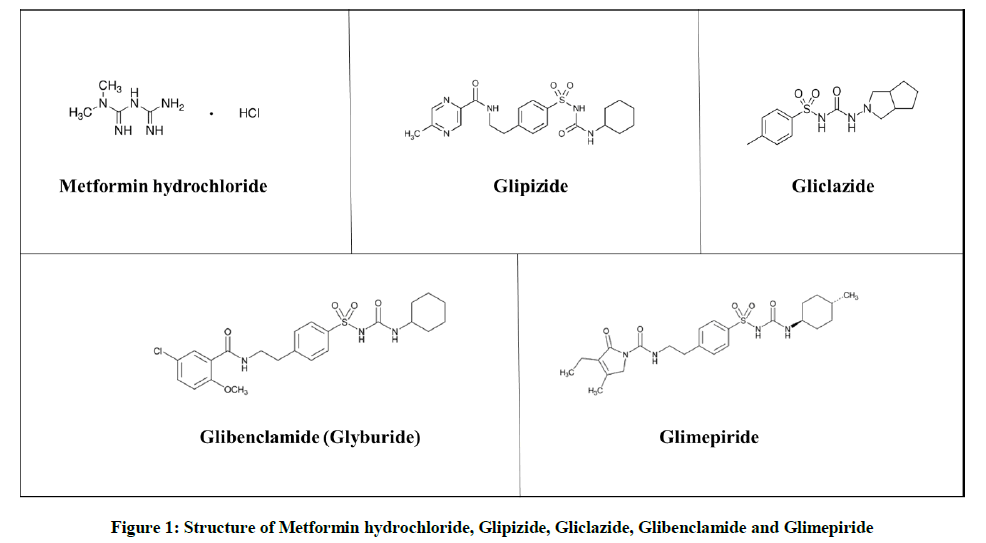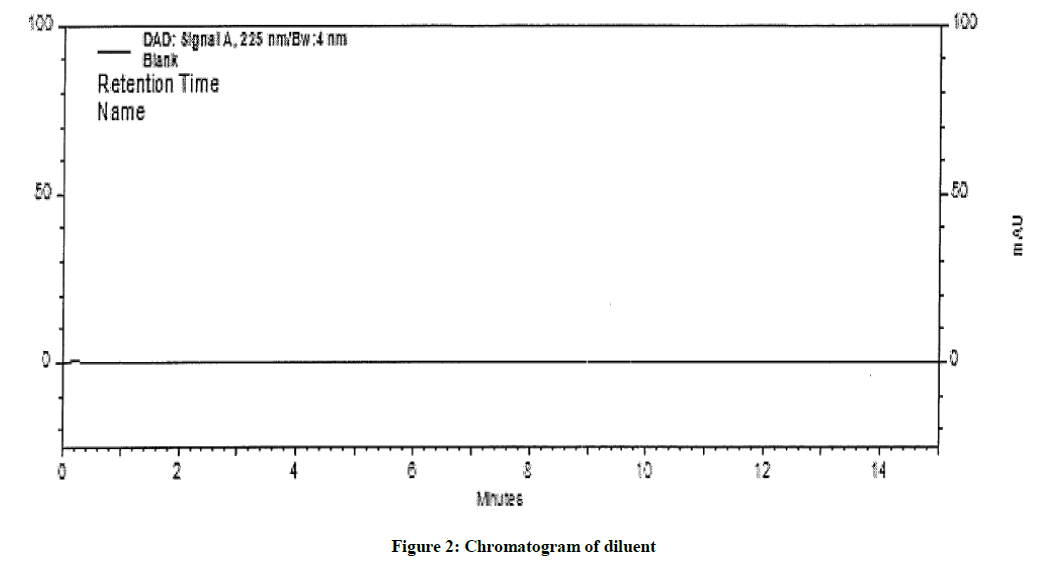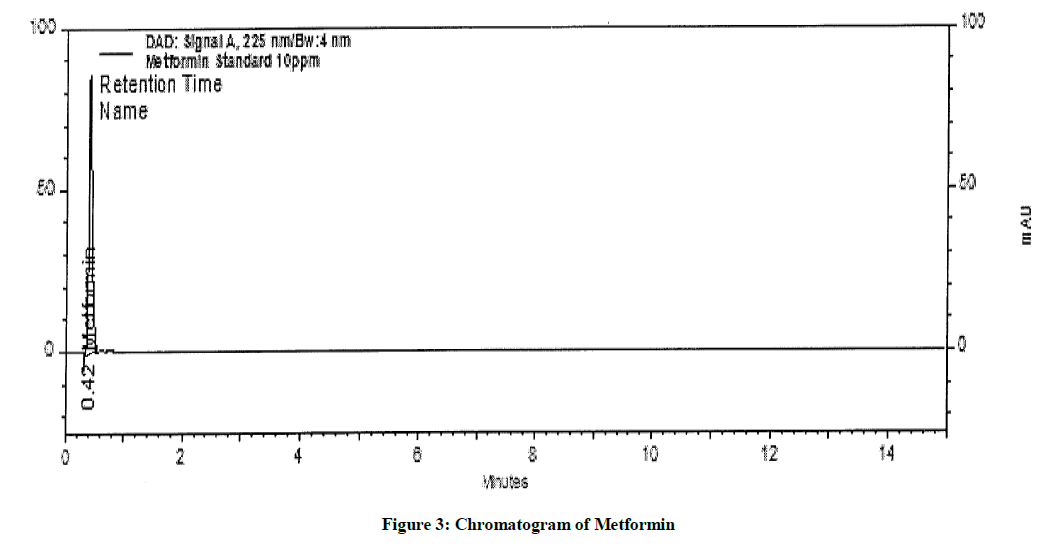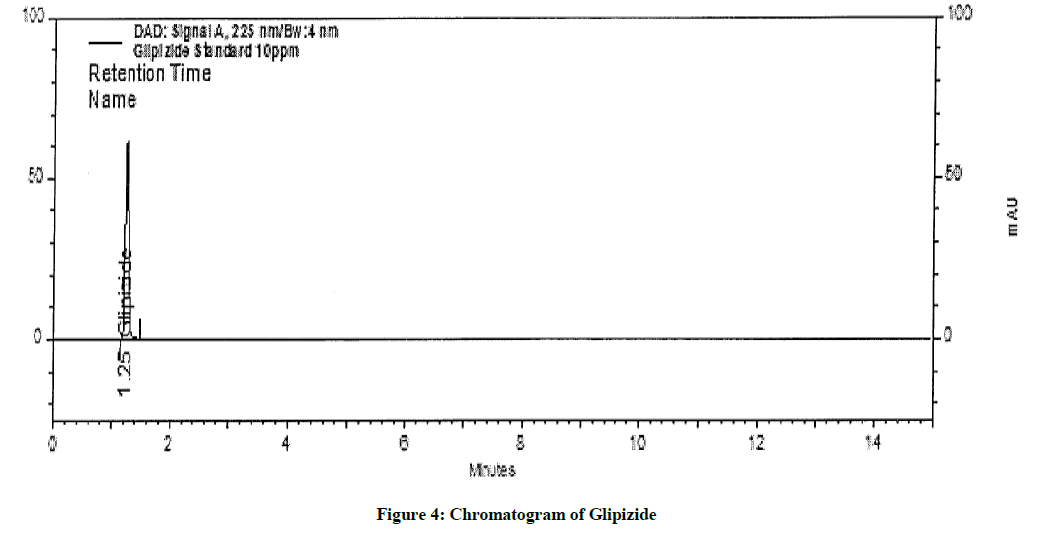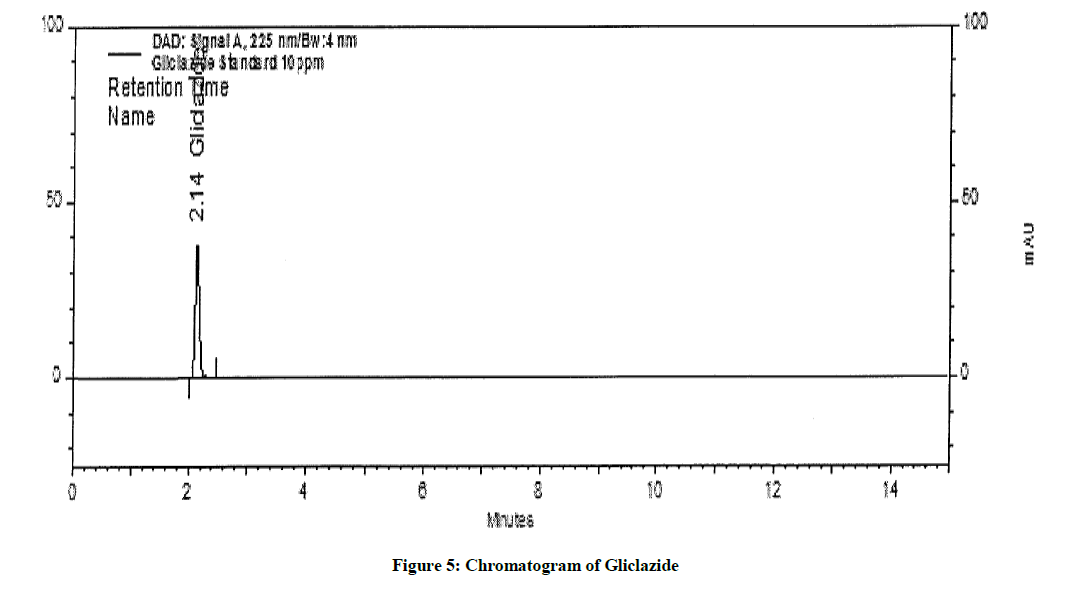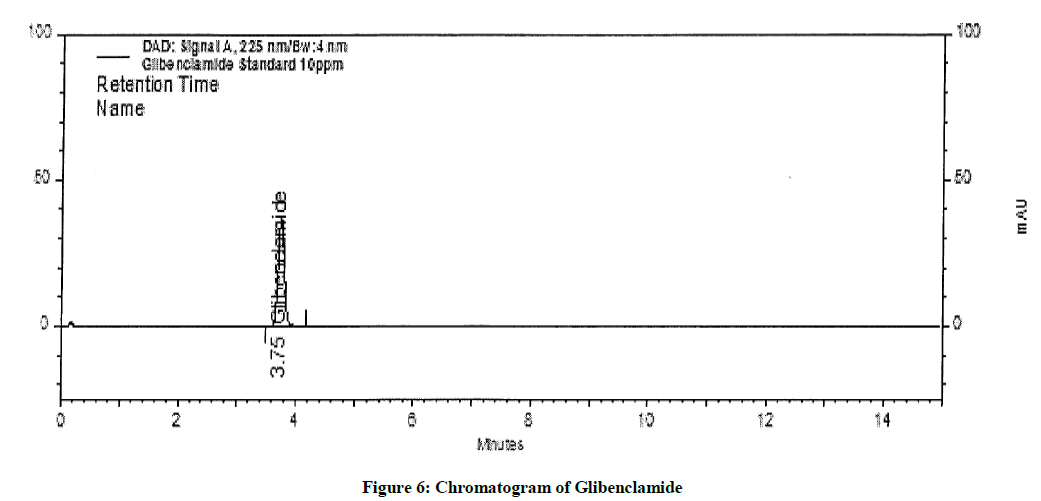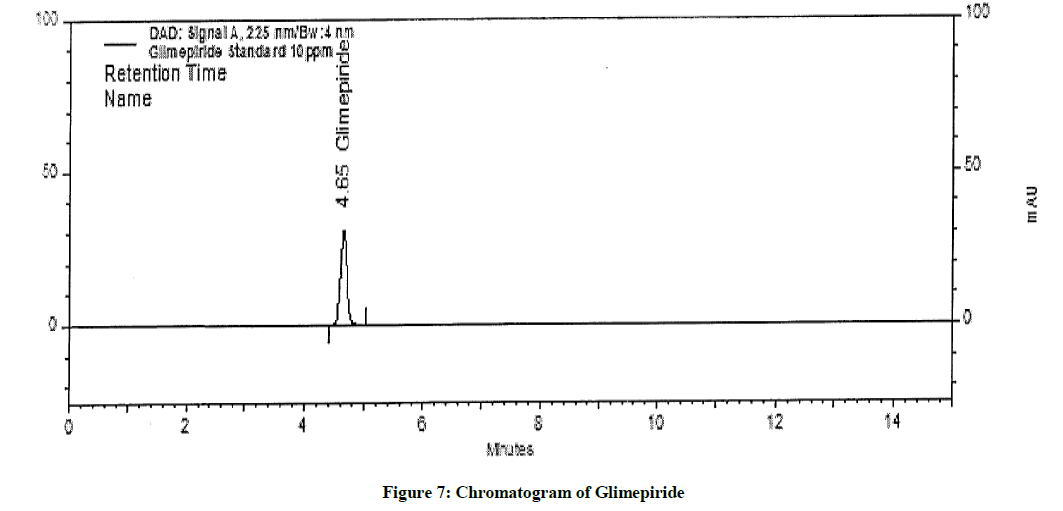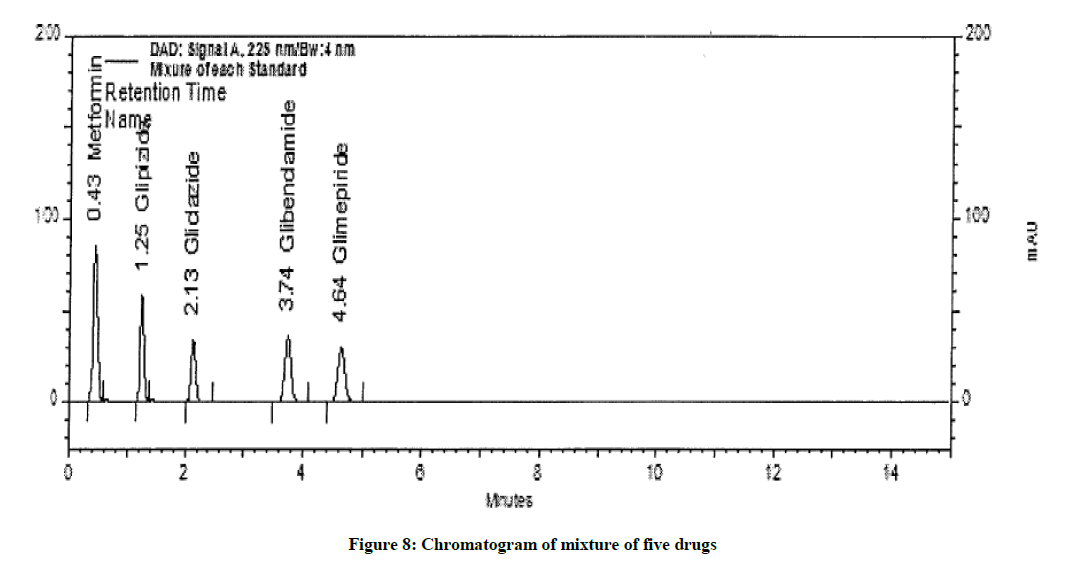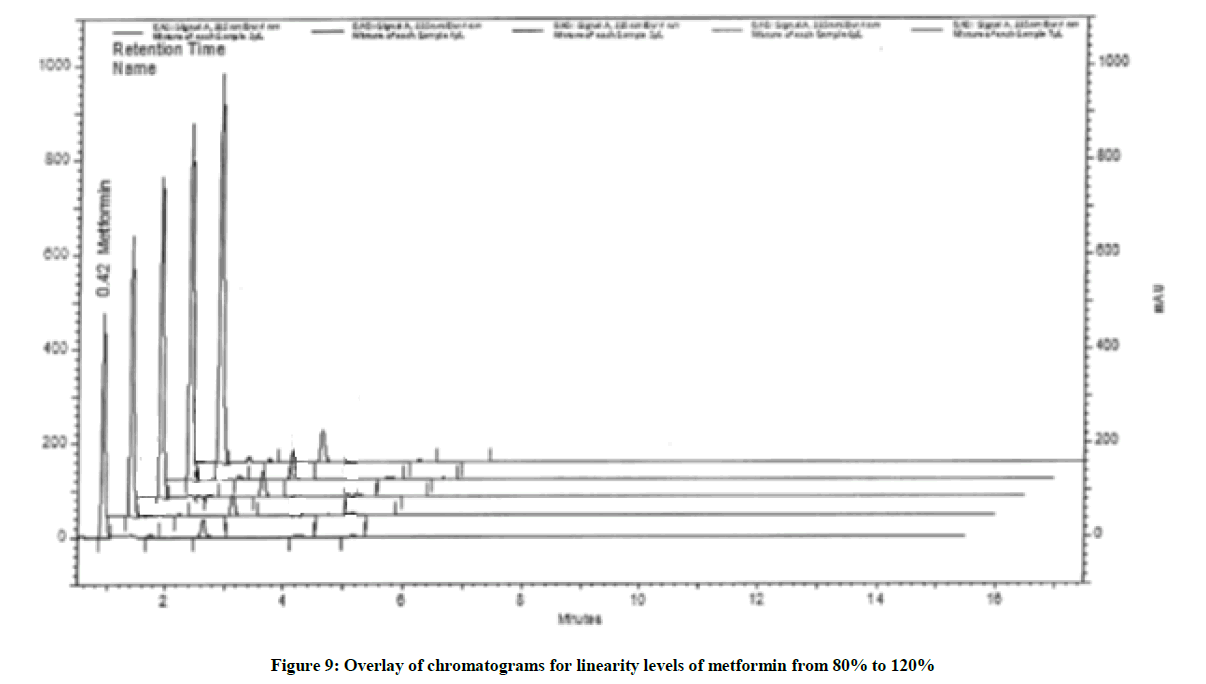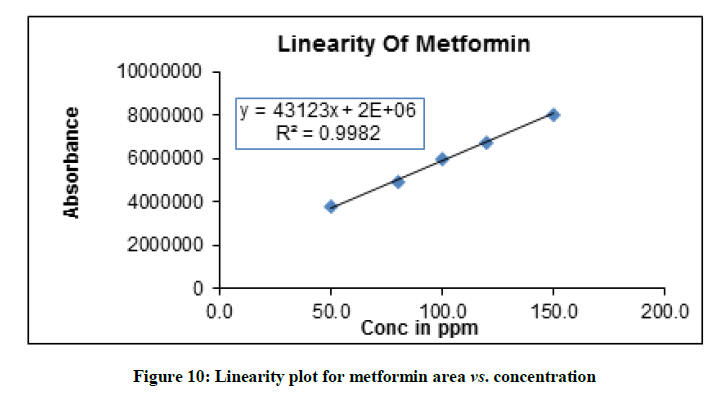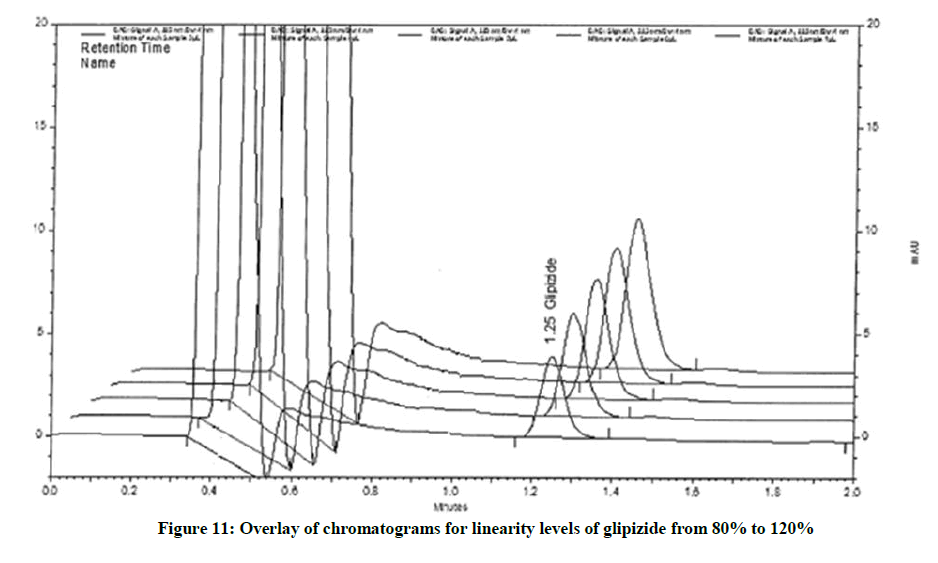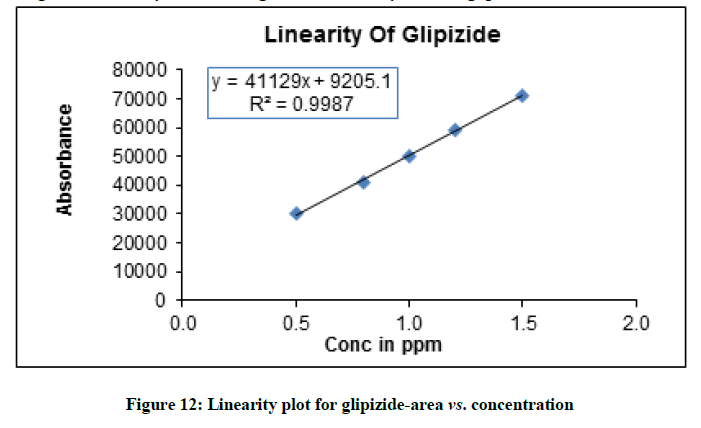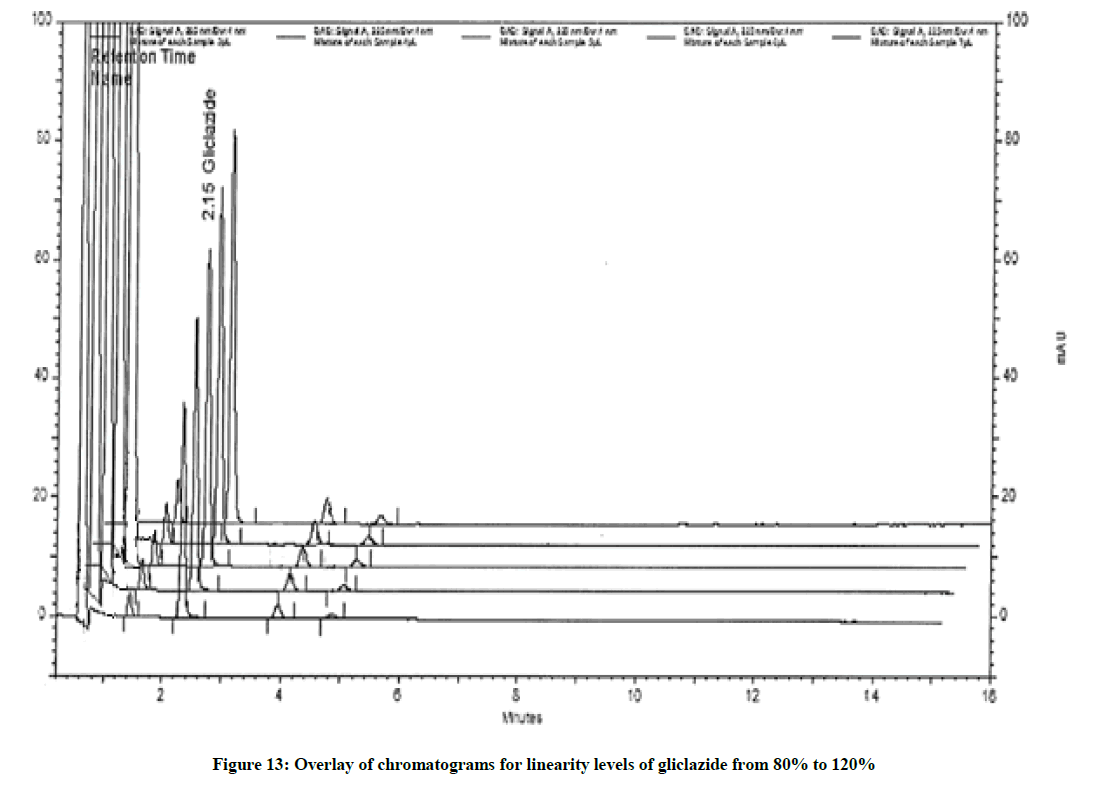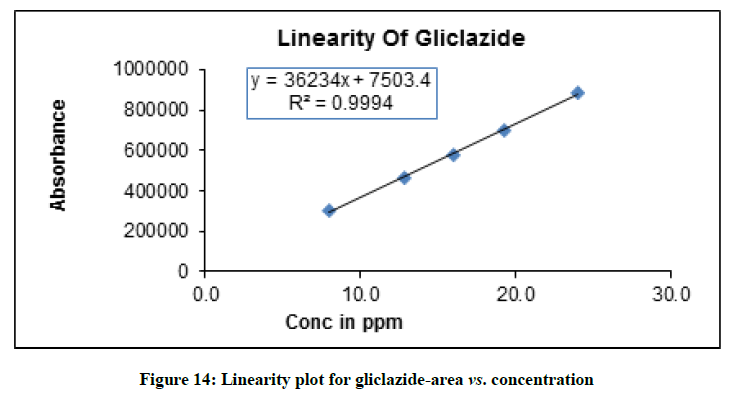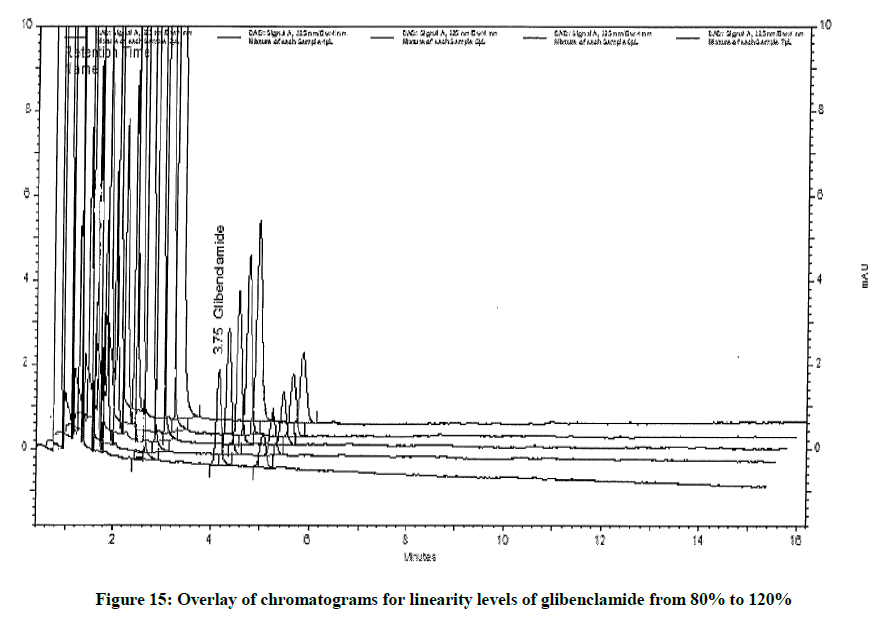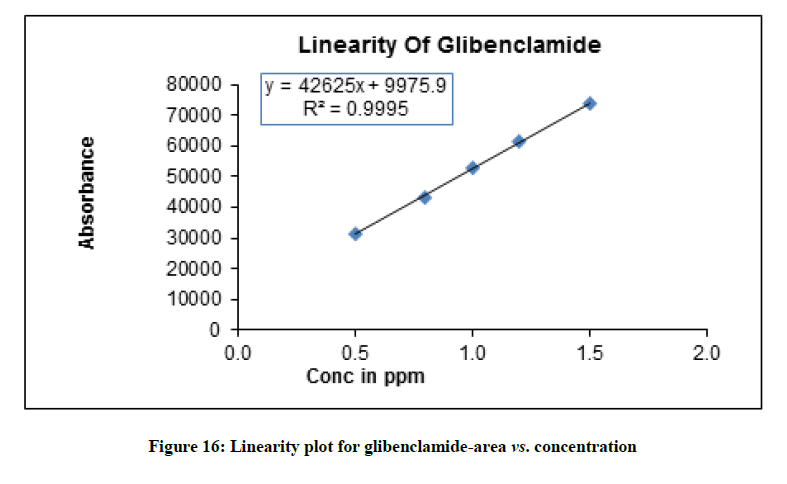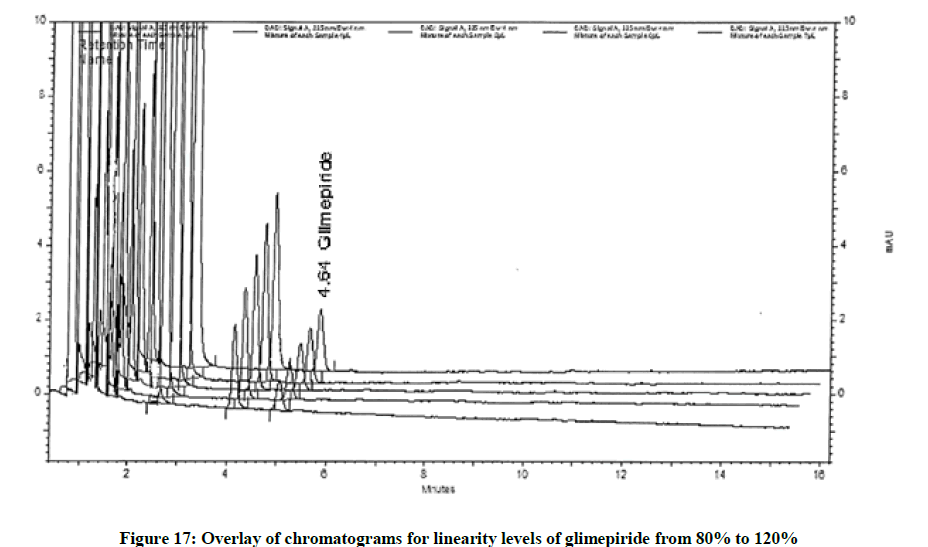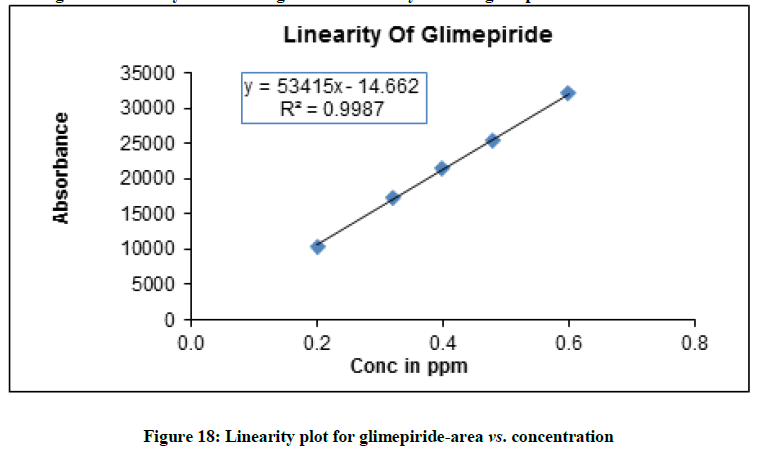Research Article - Der Pharma Chemica ( 2018) Volume 10, Issue 11
Fast Liquid Chromatography Method for Assay of Metformin and its Combination Drug from Tablet Dosage Form
Sushama Ambadekar and Sameer S Keni*
The Institute of Science, Mumbai, Maharashtra, India
Abstract
A simple, fast and effective method for Assay of Metformin along with its usual combination drugs viz: Glipizide, Gliclazide, Glibenclamide and Glimepiride has been developed for simultaneous determination for Assay of each drug from separate combination tablet of each dosage form. The developed method was validated and proved to be precise and robust. Area response were found to be linear in the concentration range of 50 ppm to 150 ppm for Metformin, 0.5 ppm to 1.5 ppm for Glipizide, 8 ppm to 24 ppm for Gliclazide, 0.5 ppm to 1.5 ppm for Glibenclamide and 0.2 ppm to 0.6 ppm for Glimepiride. The correlation coefficient was found to be 0.9991 for Metformin, 0.9994 for Glipizide, 0.9997 for Gliclazide, 0.9998 for Glibenclamide and 0.9994 for Glimepiride.
Keywords
Metformin, Glipizide, Gliclazide, Glibenclamide, Glimepiride.
Introduction
Metformin hydrochloride (1, 1-Dimethylbiguanide mono hydrochloride) has molecular formula C4H11N5.HCl and molecular weight 165.62 g/mol (Figure 1) [1]. It is an anti-hyperglycemic drug from biguanide class used in management of Type 2 diabetes. Metformin hydrochloride is a white to off-white crystalline compound and is freely soluble in water, slightly soluble in alcohol. Glipizide is 1-cyclohexyl-3-({p-[2-(5-methylpyrazinecarboxamido)ethyl] phenyl} sulfonyl)urea has molecular formula C21H27N5O4S and molecular weight 445.54 g/mol (Figure 1).
Glipizide is a short-acting, second-generation sulfonylurea with hypoglycemic activity. It is white to off-white powder and is freely soluble in dimethylformamide; soluble in 0.1 N sodium hydroxide; slightly soluble in methylene chloride. Gliclazide is 1-(3,3a,4,5,6,6a-hexahydro-1H-cyclopenta[c] pyrrol-2-yl)-3-(4-methylphenyl) sulfonylurea has molecular formula C15H21N3O3S and molecular weight 323.411 g/mol (Figure 1). Gliclazide is an oral anti-hyperglycemic agent used for the treatment of non-insulin-dependent diabetes mellitus. It belongs to the sulfonylurea class of insulin secretagogues, which act by stimulating β cells of the pancreas to release insulin.
Gliclazide is white or almost white powder. It is practically insoluble in water, freely soluble in methylene chloride, sparingly soluble in acetone, slightly soluble in ethanol (96%). Glibenclamide also known as Glyburide, is 1-[[p-[2-(5-chloro-o-anisamido)ethyl] phenyl] sulfonyl]-3-cyclo-hexylurea, with molecular formula C23H28ClN3O5S and molecular weight 494.0 (Figure 1). Glibenclamide is an anti-hyperglycemic drug of the sulfonylurea class. It is a white to off-white crystalline solid which is insoluble in water. Glimepiride is 1- [[4-[2-(3-Ethyl-4-methyl-2-oxo -3-pyrroline-1-carboxamido) ethyl] phenyl] sulfonyl]-3-(trans-4-methylcyclohexyl) urea has molecular formula C24H34N4O5S and molecular weight 490.62 g/mol (Figure 1). Glimepiride belongs to sulfonylureas class of drugs. It lowers blood sugar by causing the release of your body's natural insulin. Glimepiride is a white to almost white powder and soluble in dimethylformamide; sparingly soluble in methylene chloride; slightly soluble in methanol; practically insoluble in water.
Many antidiabetic combinations of drugs products are available along with Metformin hydrochloride. These various combination drugs are prescribed by Physicians to treat the diabetic patients on basis of patient history.
Metformin Hydrochloride and Glipizide tablets contain two anti-hyperglycemic agents with complementary mechanisms of action, to improve glycemic control in patients with type 2 diabetes. Metformin hydrochloride is an anti-hyperglycemic agent that improves glucose tolerance in patients with type 2 diabetes, lowering both basal and postprandial plasma glucose. Metformin hydrochloride decreases hepatic glucose production, decreases intestinal absorption of glucose, and improves insulin sensitivity by increasing peripheral glucose uptake and utilization. Glipizide appears to lower blood glucose acutely by stimulating the release of insulin from the pancreas, an effect dependent upon functioning beta cells in the pancreatic islets. Extra-pancreatic effects may play a part in the mechanism of action of oral sulfonylurea hypoglycemic drugs. The mechanism by which glipizide lowers blood glucose during long-term administration has not been clearly established. In man, stimulation of insulin secretion by glipizide in response to a meal is undoubtedly of major importance. Fasting insulin levels are not elevated even on long-term glipizide administration, but the postprandial insulin response continues to be enhanced after at least 6 months of treatment [2].
Metformin hydrochloride and Glibenclamide tablets contain two oral anti-hyperglycemic drugs used in the management of type 2 diabetes, i.e. Metformin hydrochloride and Glibenclamide. This combines’ two anti-hyperglycemic agents with complementary mechanisms of action, to improve glycemic control in patients with type 2 diabetes. Action of Metformin is already discussed. Glibenclamide appears to lower blood glucose acutely by stimulating the release of insulin from the pancreas, an effect dependent upon functioning beta cells in the pancreatic islets. With chronic administration in patients with type 2 diabetes, the blood glucose lowering effect persists despite a gradual decline in the insulin secretory response to the drug. Extra-pancreatic effects may be involved in the mechanism of action of oral sulfonylurea hypoglycemic drugs [3].
Metformin hydrochloride and Gliclazide tablets contain two oral anti-hyperglycemic drugs used in the management of type 2 diabetes, i.e. Metformin hydrochloride and Gliclazide. Gliclazide is a sulfonylurea which works by increasing the amount of insulin released by the pancreas in order to lower the blood glucose. Metformin is a biguanide which works by lowering glucose production in the liver, delaying glucose absorption from intestines and increasing the body's sensitivity to insulin.
Metformin hydrochloride and Glimepiride tablets contain two oral anti-hyperglycemic drugs used in the management of type 2 diabetes, i.e. Metformin hydrochloride and Glimepiride. Glimepiride stimulates the insulin release from functioning pancreatic β-cells and inhibits gluconeogenesis at hepatic cells. It also increases insulin sensitivity at peripheral target sites.
This research work is aimed to develop single analytical method for different combinations of anti-diabetic drug along with Metformin Hydrochloride. Since many combinations tablet dosage forms as mentioned in above paragraph are available, present study is targeted to develop and validate a fast, economic and reliable method of analysis using HPLC for determination of Assay of Metformin Hydrochloride and combination anti- diabetic drugs. If we sum up the number of drugs considered in the combination tablet dosage forms, there are five drugs. Hence a single HPLC method is been developed that will specifically resolve each API peak so that each one can be accurately quantitated. Second aim is to develop a shorter run time method, so that the costly HPLC resources can be saved. Literature survey reveals few chromatographic methods for estimation of combination drugs from various formulation dosage forms [4-11]. United States Pharmacopoeia has an official monograph for Glibenclamide and Metformin hydrochloride tablets consisting of separate HPLC methods for Assay and Impurities of Glibenclamide and Metformin respectively [1]. Also a monograph of Glipizide and Metformin Hydrochloride tablets is present. This method too mentions separate methods for Assay and Impurity of Glipizide and Metformin Hydrochloride [1].
Materials and Methods
Chemicals and reagents
Metformin, Glipizide, Gliclazide, Glibenclamide and Glimepiride were obtained from various API suppliers, as a free sample for academic research. These API were used as working standard. Various combination tablets along with Metformin HCl, viz: Metformin Hydrochloride 500 mg and Glipizide 5 mg tablets, Metformin hydrochloride 500 mg and Glibenclamide 5 mg tablets, Metformin hydrochloride 500 mg and Gliclazide 80 mg tablets and Metformin hydrochloride 500 mg and Glimepiride 2 mg tablets were purchased from local medical stores. Orthophosphoric acid (85%) was used of Thomas Baker make and Triethylamine was used of Merck make. Methanol and Acetonitrile used were AR grade solvents of Rankem Ltd. Purified water used was from Millipore water purification system.
Instruments and equipment
HPLC instrument of the make-Agilent, Model no. 1200 series was used in the experiment. Ultrasound Sonicator of local make was used during sample preparation.
Chromatographic conditions on HPLC
Flow rate: 0.3 ml/min, Wavelength: 225 nm, Injection volume: 5 μl, Column oven: 35°C, Column: Acquity UPLC BEH C8, 2.1 × 50 mm, 1.7 μ. Mobile phase-Buffer: Acetonitrile (60: 40), Buffer solution: 1 ml Orthophosphoric acid + 1 ml Triethylamine in 1000 ml of water.
Method of analysis
A single method of analysis is developed for four different combination of drug along with Metformin, as a common drug. Hence, here standards are prepared individually for each drug and sample solution of formulation are prepared for two drugs in combination form, as they appear in individual combination tablets. Users can select there combination drugs as per requirement and prepare the standard solution and sample solutions accordingly.
Preparation of diluent
Methanol was used as diluent.
Preparation of metformin hydrochloride standard (100 ppm)
About 25 mg of Metformin HCl standard was accurately weighed and dissolved in sufficient diluent and diluted to 50 ml in a volumetric flask. Further, 5 ml of stock solution is diluted to 25 ml with mobile phase.
Preparation of glipizide standard (1 ppm)
About 20 mg of Glipizide standard was accurately weighed and dissolved in sufficient diluent and diluted to 200 ml in a volumetric flask. Further, 1 ml of stock solution is diluted to 100 ml with mobile phase.
Preparation of gliclazide standard (16 ppm)
About 40 mg of Gliclazide standard was accurately weighed and dissolved in sufficient diluent and diluted to 50 ml in a volumetric flask. Further, 5 ml of stock solution is diluted to 250 ml with mobile phase.
Preparation of glibenclamide standard (1 ppm)
About 20 mg of Glibenclamide standard was accurately weighed and dissolved in sufficient diluent and diluted to 200 ml in a volumetric flask. Further, 1 ml of stock solution is diluted to 100 ml with mobile phase.
Preparation of glimepiride standard (0.4 ppm)
About 20 mg of Glimepiride standard was accurately weighed and dissolved in sufficient diluent and diluted to 500 ml in a volumetric flask. Further, 1 ml of stock solution is diluted to 100 ml with mobile phase.
Estimation of metformin and glipizide from tablet dosage form
Few intact tablets were crushed to fine powder. Powder equivalent to 1 tablet had been transferred into a dry 100 ml volumetric flask. About 50 ml of methanol was added to this flask. Swirl to mix the contents and sonicated for 30 min with intermittent shaking. After sonication contents of flask was cooled to room temperature and diluted to volume upto the mark with diluent. From this solution, 4 ml of solution is diluted to 200 ml with diluent. Further, the solution is filtered with 0.45 μ filter porosity membrane filter before use.
Estimation of metformin and gliclazide from tablet dosage form
Few intact tablets were crushed to fine powder. Powder equivalent to 1 tablet had been transferred into a dry 100 ml volumetric flask About 50 ml of methanol was added to this flask. Swirl to mix the contents and sonicated for 30 min with intermittent shaking. After sonication contents of flask was cooled to room temperature and diluted to volume upto the mark with diluent. From this solution, 5 ml of solution is diluted to 250 ml with diluent. Further, the solution is filtered with 0.45 μ filter porosity membrane filter before use.
Estimation of metformin and glibenclamide from tablet dosage form
Few intact tablets were crushed to fine powder. Powder equivalent to 1 tablet had been transferred into a dry 100 ml volumetric flask. About 50 ml of methanol was added to this flask. Swirl to mix the contents and sonicated for 30 min with intermittent shaking. After sonication contents of flask was cooled to room temperature and diluted to volume upto the mark with diluent. From this solution, 4 ml of solution is diluted to 200 ml with diluent. Further, the solution is filtered with 0.45 μ filter porosity membrane filter before use.
Estimation of metformin and glimepiride from tablet dosage form
Few intact tablets were crushed to fine powder. Powder equivalent to 1 tablet had been transferred into a dry 100 ml volumetric flask. About 50 ml of methanol was added to this flask. Swirl to mix the contents and sonicated for 30 min with intermittent shaking. After sonication contents of flask was cooled to room temperature and diluted to volume upto the mark with diluent. From this solution, 4 ml of solution is diluted to 200 ml with diluent. Further, the solution is filtered with 0.45 μ filter porosity membrane filter before use.
Results and Discussion
Method optimization and development
Metformin HCl is available as single drug tablet and also along with other antidiabetic drug for diabetic patients. In present work four drugs along with Metformin are considered. A smart method that would accommodate possible combination drugs would help the analyst to estimate the contents of drugs in various combinations, using one method. Hence considering the solubility and chemical characteristics this method was developed. A simple mobile phase consisting of Orthophosphoric acid and Triethylamine was prepared. Various HPLC columns were used to achieve better separation and shorter run time. Finally an HPLC column with sub-two micron particle size of 1.7 μ was selected and method was optimized to get an acceptable separation of all drugs that too in a shorter run time. Wavelength selected was such that no interference shall be observed from diluent and drugs at retention time of each other. Single API was injected to confirm Retention time and also a solution of all drugs in combination were injected to confirm Retention time of API in each other’s presence.
Method validation
The method hence developed for each drug from combination tablets was validated for the Assay test of Metformin and other drug from combination tablet, separately using validation parameters as mentioned in ICH guidelines [12]. The validation parameters that consisted of usage of only standards were carried out in common for all drugs. However other parameters that required usage of sample were carried out separately of each combination.
Specificity
Firstly diluent was injected to check its interference. The Specific and Selective nature of method for Metformin, Glipizide, Gliclazide, Glibenclamide and Glimepiride was proved by injecting each drug separately in single injection (Figures 2-8). The sample was then injected for combination tablets. No interference for diluent and each API were found at the retention time of other API (Table 1). Hence the method is selective for assay of Metformin and each drug at 225 nm.
| Injection for ↓ | Retention time in minutes↓ | ||||
|---|---|---|---|---|---|
| Diluent | No peak | No peak | No peak | No peak | No peak |
| Metformin | 0.42 | No peak | No peak | No peak | No peak |
| Glipizide | No peak | 1.25 | No peak | No peak | No peak |
| Gliclazide | No peak | No peak | 2.14 | No peak | No peak |
| Glibenclamide | No peak | No peak | No peak | 3.75 | No peak |
| Glimepiride | No peak | No peak | No peak | No peak | 4.65 |
| Mixture of 5 API | 0.43 | 1.25 | 2.13 | 3.74 | 4.64 |
Table 1: Specificity summary for retention time of analyte
Precision
For precision of method, System precision, Method precision and Intermediate precision was carried out. System precision was carried out on five replicate measurements of Metformin and other four API standard solution. For system precision (Table 2), the %RSD for area response should be less than 2%. Method precision was carried out by preparing sample solution six times for each combination tablet of Metformin along with typical drug (Tables 3-6). The Assay value and the %RSD were calculated. For Method precision, %RSD should be less than 2%. Intermediate precision (Tables 7-10) was carried out by carrying out the precision experiment on different day by different analyst. For intermediate precision, % cumulative RSD of 12 preparations of precision and intermediate precision should not be more than 2%.
| Replicates | Metformin | Glipizide | Gliclazide | Glibenclamide | Glimepiride |
|---|---|---|---|---|---|
| 1 | 5984480 | 50324 | 586785 | 52667 | 21505 |
| 2 | 5954637 | 50832 | 588632 | 52786 | 21638 |
| 3 | 5945367 | 50319 | 583748 | 52820 | 21283 |
| 4 | 5938232 | 50381 | 581028 | 52429 | 21901 |
| 5 | 5934560 | 50928 | 583848 | 52557 | 21734 |
| Mean | 5951455 | 50557 | 584808 | 52652 | 21612 |
| %RSD | 0.34 | 0.59 | 0.5 | 0.31 | 1.08 |
Table 2: System precision for five API
| Sample no. | mg/tablet of Metformin HCl | % Assay | mg/tablet of Glipizide | % Assay |
|---|---|---|---|---|
| Precision 1 | 501.14 | 100.23 | 4.87 | 97.47 |
| Precision 2 | 502.68 | 100.54 | 4.84 | 96.86 |
| Precision 3 | 503.83 | 100.77 | 4.88 | 97.54 |
| Precision 4 | 499.11 | 99.82 | 4.84 | 96.83 |
| Precision 5 | 506.19 | 101.24 | 4.85 | 97.04 |
| Precision 6 | 506.14 | 101.23 | 4.75 | 95 |
| Average | 503.18 | 100.64 | 4.84 | 96.79 |
| % RSD | - | 0.56 | - | 0.96 |
Table 3: Method precision for Metformin and Glipizide combination tablet
| Sample no. | mg/tablet of Metformin HCl | % Assay | mg/tablet of Gliclazide | % Assay |
|---|---|---|---|---|
| Precision 1 | 504.43 | 100.89 | 79.52 | 99.4 |
| Precision 2 | 504.69 | 100.94 | 78.79 | 98.49 |
| Precision 3 | 504.6 | 100.92 | 78.47 | 98.09 |
| Precision 4 | 500.51 | 100.1 | 79.9 | 99.88 |
| Precision 5 | 504.16 | 100.83 | 77.61 | 97.01 |
| Precision 6 | 507.34 | 101.47 | 78.23 | 97.79 |
| Average | 504.29 | 100.86 | 78.75 | 98.44 |
| % RSD | - | 0.43 | - | 1.08 |
Table 4: Method precision for Metformin and Gliclazide combination tablet
| Sample no. | mg/tablet of Metformin HCl | % Assay | mg/tablet of Glibenclamide | % Assay |
|---|---|---|---|---|
| Precision 1 | 503.24 | 100.65 | 4.96 | 99.25 |
| Precision 2 | 502.58 | 100.52 | 4.97 | 99.42 |
| Precision 3 | 503.9 | 100.78 | 4.94 | 98.82 |
| Precision 4 | 503.68 | 100.74 | 4.98 | 99.55 |
| Precision 5 | 499.92 | 99.98 | 5 | 99.96 |
| Precision 6 | 498.61 | 99.72 | 4.99 | 99.78 |
| Average | 501.99 | 100.4 | 4.97 | 99.46 |
| % RSD | - | 0.44 | - | 0.4 |
Table 5: Method precision for Metformin and Glibenclamide combination tablet
| Sample no. | mg/tablet of Metformin HCl | % Assay | mg/tablet of Glimepiride | % Assay |
|---|---|---|---|---|
| Precision 1 | 512.01 | 102.4 | 1.98 | 99 |
| Precision 2 | 500.43 | 100.09 | 1.94 | 96.9 |
| Precision 3 | 506.32 | 101.26 | 1.97 | 98.33 |
| Precision 4 | 500.32 | 100.06 | 1.95 | 97.54 |
| Precision 5 | 503.42 | 100.68 | 1.94 | 97.18 |
| Precision 6 | 503.12 | 100.62 | 1.98 | 98.82 |
| Average | 504.27 | 100.85 | 1.96 | 97.96 |
| % RSD | - | 0.87 | - | 0.9 |
Table 6: Method precision for Metformin and Glimepiride combination tablet
| Sample no. | mg/tablet of Metformin HCl | % Assay | mg/tablet of Glipizide | % Assay |
|---|---|---|---|---|
| Int. Precision 1 | 503.98 | 100.8 | 4.94 | 98.74 |
| Int. Precision 2 | 509.87 | 101.97 | 4.87 | 97.34 |
| Int. Precision 3 | 506.25 | 101.25 | 4.86 | 97.27 |
| Int. Precision 4 | 512.96 | 102.59 | 4.98 | 99.55 |
| Int. Precision 5 | 509.54 | 101.91 | 4.83 | 96.56 |
| Int. Precision 6 | 503.67 | 100.73 | 4.93 | 98.57 |
| Average | 507.71 | 101.54 | 4.94 | 98.01 |
| % Cumulative RSD | - | 0.77 | - | 1.2 |
Table 7: Intermediate precision for Metformin and Glipizide combination tablet
| Sample no. | mg/tablet of Metformin HCl | % Assay | mg/tablet of Gliclazide | % Assay |
|---|---|---|---|---|
| Int. Precision 1 | 501.06 | 100.21 | 79.31 | 99.13 |
| Int. Precision 2 | 509.72 | 101.94 | 80.47 | 100.59 |
| Int. Precision 3 | 502.33 | 100.47 | 78.83 | 98.53 |
| Int. Precision 4 | 501.18 | 100.24 | 78.35 | 97.94 |
| Int. Precision 5 | 501.7 | 100.34 | 78.33 | 97.91 |
| Int. Precision 6 | 511.88 | 102.38 | 80.63 | 100.79 |
| Average | 504.64 | 100.93 | 79.31 | 99.15 |
| % Cumulative RSD | - | 0.71 | - | 1.19 |
Table 8: Intermediate precision for Metformin and Gliclazide combination tablet
| Sample no. | mg/tablet of Metformin HCl | % Assay | mg/tablet of Glibenclamide | % Assay |
|---|---|---|---|---|
| Int. Precision 1 | 500.29 | 100.06 | 4.97 | 99.47 |
| Int. Precision 2 | 499.16 | 99.83 | 4.99 | 99.8 |
| Int. Precision 3 | 493.7 | 98.74 | 4.9 | 98.03 |
| Int. Precision 4 | 494.24 | 98.85 | 4.96 | 99.24 |
| Int. Precision 5 | 493.27 | 98.65 | 4.9 | 97.99 |
| Int. Precision 6 | 495.87 | 99.17 | 4.91 | 98.19 |
| Average | 496.09 | 99.22 | 4.97 | 98.79 |
| % Cumulative RSD | - | 0.79 | - | 0.71 |
Table 9: Intermediate precision for Metformin and Glibenclamide combination tablet
| Sample no. | mg/tablet of Metformin HCl | % Assay | mg/tablet of Glimepiride | % Assay |
|---|---|---|---|---|
| Int. Precision 1 | 504.35 | 100.87 | 1.98 | 98.77 |
| Int. Precision 2 | 506.01 | 101.2 | 1.96 | 98.07 |
| Int. Precision 3 | 507.98 | 101.6 | 1.96 | 98.18 |
| Int. Precision 4 | 506.74 | 101.35 | 1.97 | 98.67 |
| Int. Precision 5 | 503.43 | 100.69 | 1.94 | 97.22 |
| Int. Precision 6 | 500.08 | 100.02 | 2 | 100.06 |
| Average | 504.77 | 100.95 | 1.97 | 98.49 |
| % Cumulative RSD | - | 0.7 | - | 0.93 |
Table 10: Intermediate precision for Metformin and Glimepiride combination tablet
For system precision, method precision and intermediate precision, all the result values for validation parameters were found to be within acceptance criteria Hence it is concluded that the method was precise and rugged.
Linearity and range
For determination of Linearity and Range of the method, five solutions of different concentration from 80% to 120% (Figures 9-18) of the working level of sample, for each drug were prepared. Area response of these solutions was recorded after injecting on HPLC system. Correlation coefficient, Slope and Intercept was determined by statistical calculations. For a method to be linear within the workable range, the Correlation coefficient should be more than 0.99.
From the linearity data and the subsequent statistical analysis, following results were found as mentioned below (Table 11).
| Drug ↓ | Working range | Correlation coefficient (R) | Slope | Y- Intercept |
|---|---|---|---|---|
| Metformin | 50 to 150 ppm | 0.9991 | 43123 | 1580872 |
| Glipizide | 0.5 to 1.5 ppm | 0.9994 | 41129 | 9205 |
| Gliclazide | 8 to 24 ppm | 0.9997 | 36234 | 7503 |
| Glibenclamide | 0.5 to 1.5 ppm | 0.9998 | 42625 | 9975 |
| Glimepiride | 0.2 to 0.6 ppm | 0.9994 | 53415 | -15 |
Table 11: Results obtained from the statistical analysis
Hence it is concluded that the method is Linear within the predefined working range of drug.
Accuracy
Accuracy was determined by recovery study of Metformin and each drug combination (Table 12), at three levels in the range of 80% to 120%. For a method to be accurate, the mean recovery should be between 98.0 to 102.0%.
| Recovery levels→ | 80% | 100% | 120% | Mean recovery |
|---|---|---|---|---|
| Metformin and Glipizide tablet | ||||
| Metformin | 99.3 | 101 | 101.2 | 100.5 |
| Glipizide | 98.7 | 99.8 | 99.8 | 99.4 |
| Metformin and Gliclazide tablet | ||||
| Metformin | 99.4 | 99.6 | 99.3 | 99.5 |
| Gliclazide | 99.9 | 100.2 | 100.5 | 100.2 |
| Metformin and Glibenclamide tablet | ||||
| Metformin | 99.8 | 100 | 101.1 | 100.3 |
| Glibenclamide | 100 | 99.6 | 99.9 | 99.8 |
| Metformin and Glimepiride tablet | ||||
| Metformin | 99.6 | 99.1 | 99.4 | 99.4 |
| Glimepiride | 99.5 | 99.4 | 99.6 | 99.5 |
Table 12: Recovery results for metformin and combination tablet method
On the basis of these results, it is proved that the method is accurate for recovery of Metformin and other four drugs, viz: Glipizide, Gliclazide, Glibenclamide and Glimepiride, from each combination tablet.
Robustness
Robust nature of method needs to be proved by small deliberate change in the experimental condition. For robustness deliberate changes in HPLC method parameters were done, which were as follows:
▪ Change in wavelength
▪ Change in Flow rate
▪ Change in temperature
The results from deliberately changed conditions were compared with as such conditions. For a method to be robust, the absolute difference between as such condition and deliberately changed condition should not be more than 2.0%. The results for % difference in Assay value at are compiled in below Table 13.
| Metformin and Glipizide tablet | ||||
| Metformin | %difference | Glipizide | %difference | |
| As such condition Assay results | 100.23 | - | 97.47 | - |
| Change in wavelength (+1 nm) | 100.43 | 0.2 | 97.45 | 0.02 |
| Change in wavelength (-1 nm) | 99.57 | 0.65 | 97.29 | 0.17 |
| Change in Flow rate (+0.05 ml) | 99.81 | 0.42 | 96.5 | 0.97 |
| Change in Flow rate (-0.05 ml) | 99.23 | 0.99 | 96.72 | 0.74 |
| Change in temperature (+2ºC) | 99.01 | 1.22 | 98.11 | 0.64 |
| Change in temperature (-2ºC) | 99.65 | 0.58 | 96.45 | 1.01 |
| Metformin and Gliclazide tablet | ||||
| Metformin | %difference | Gliclazide | %difference | |
| As such condition Assay results | 100.89 | - | 99.4 | - |
| Change in wavelength (+1 nm) | 101.3 | 0.41 | 98.52 | 0.88 |
| Change in wavelength (-1 nm) | 99.89 | 1 | 99.03 | 0.37 |
| Change in Flow rate (+0.05 ml) | 100.1 | 0.79 | 98.56 | 0.84 |
| Change in Flow rate (-0.05 ml) | 100.47 | 0.42 | 99.81 | 0.41 |
| Change in temperature (+2ºC) | 100.11 | 0.78 | 99.17 | 0.24 |
| Change in temperature (-2ºC) | 99.22 | 1.67 | 99.35 | 0.05 |
| Metformin and Glibenclamide tablet | ||||
| Metformin | %difference | Glibenclamide | %difference | |
| As such condition Assay results | 100.65 | - | 99.25 | - |
| Change in wavelength (+1 nm) | 100.27 | 0.38 | 98.82 | 0.43 |
| Change in wavelength (-1 nm) | 100.89 | 0.24 | 98.66 | 0.59 |
| Change in Flow rate (+0.05 ml) | 100.77 | 0.12 | 99.82 | 0.57 |
| Change in Flow rate (-0.05 ml) | 100.54 | 0.1 | 99.69 | 0.44 |
| Change in temperature (+2ºC) | 100.98 | 0.33 | 99.01 | 0.24 |
| Change in temperature (-2ºC) | 99.98 | 0.66 | 100 | 0.75 |
| Metformin and Glimepiride tablet | ||||
| Metformin | %difference | Glimepiride | %difference | |
| As such condition Assay results | 102.4 | - | 99 | - |
| Change in wavelength (+1 nm) | 100.9 | 1.5 | 98.21 | 0.79 |
| Change in wavelength (-1 nm) | 101.67 | 0.73 | 98.9 | 0.1 |
| Change in Flow rate (+0.05 ml) | 102.23 | 0.17 | 99.44 | 0.44 |
| Change in Flow rate (-0.05 ml) | 102.79 | 0.39 | 98.54 | 0.46 |
| Change in temperature (+2ºC) | 101.73 | 0.67 | 98.82 | 0.19 |
| Change in temperature (-2ºC) | 102.5 | 0.1 | 98.35 | 0.65 |
Table 13: Robustness results for Metformin and combination tablet method
As results were within the acceptable criteria even after deliberate change to the experimental conditions, it is proved that the method remained unaffected by small variations of parameter.
Conclusion
A single analytical method by HPLC for the determination of Assay of Metformin and its four combination drug viz: Glipizide, Gliclazide, Glibenclamide and Glimepiride, from combination tablet is developed and validated. The developed method was found to be specific, accurate, precise, linear and robust for its intended use.
References
- United States Pharmacopoeia, National formulary-36, 2018, 2614, 8549, 1964, 1953.
- https://www.drugs.com/pro/glipizide-and-metformin.html.
- https://www.drugs.com/pro/Glibenclamide-and-metformin-tablets.html.
- Gadapa Nirupa, J. Chem., 2013.
- Damayanthi Dal, J. Pharm. Res., 2017, 11(5), 525-530.
- Sarif Niroush, Karbala Int. J. Modern Sci., 2015, 1(1), 39-48.
- Chandrabatla Varaprasad, Rasayan J. Chem., 2015, 8(4), 426-432.
- Angshuman Biswas, IJSIT, 2012, 1(2), 98-105
- Shraddha Pawar, Der Pharma Chemica, 2010, 2 (4), 157-168.
- Akula, Int. J. Pharm. Pharm. Sci., 2013, 5(4), 511-517.
- P.M. Vasanth, Der Pharmacia Lettre., 2013, 5(5), 168-174.
- ICH Guideline Q2 (R1), Validation of Analytical procedures: Text and Methodology, 1994.

